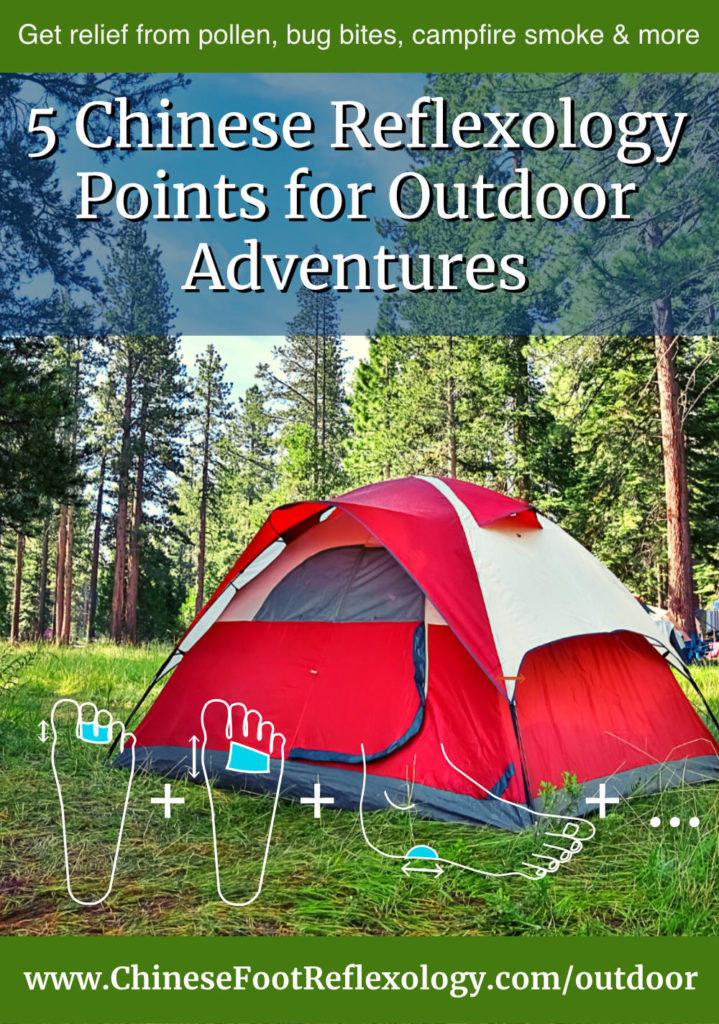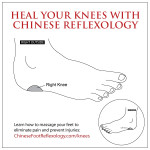Whether you’re hiking, biking, camping, or just chillaxin’ at a backyard barbecue, here are the top five must-know Chinese Reflexology points for outdoor adventures. Please feel free to bookmark this page for useful reflexology points to help with:
- Pollen: allergies and itchy eyes
- Campfire smoke: irritated lungs and watery eyes
- Sore knees: too much hiking, biking, or overuse
- Constipation: feeling uncomfortable doing your business at the campground or your host’s home
- Bug bites: how to clear swelling and itching faster
1. Chinese Reflexology Lung Point
The Lung point is helpful for both pollen and campfire smoke. Ever notice how the smoke from a campfire blows in your face no matter where you’re sitting? You could move your camp chair to the opposite side, but the smoke seems to follow you around. Smoke’s not the only thing that can irritate your lungs. When your outdoors, there’s lots of pollen too.
 This year was particularly bad here in Northern California. The pollen was so plentiful this spring that you could see clouds of pollen in the air. I don’t even have allergies, but walking into a pollen poof made me sneeze.
This year was particularly bad here in Northern California. The pollen was so plentiful this spring that you could see clouds of pollen in the air. I don’t even have allergies, but walking into a pollen poof made me sneeze.
If you find yourself coughing or sneezing—whether it’s from smoke or pollen— the Chinese Reflexology Lung point soothes and strengthens Lung qi (life force energy and flow in the Lungs) to help you breathe easier.
How to Locate and Massage the Chinese Reflexology Point for the Lungs

- Location: You’ll find a Lung point on each of your feet. This reflexology “point” is actually a rectangular-shaped area located on the ball of your foot. It’s the area on the ball just under your three middle toes.
- How to massage: To massage the Lung reflexology point, pull your foot up into your lap. Then wrap the fingers of both hands around your foot, and press into your Lung point using with both of your thumb pads. You can massage in small circles across and down the point.
- How often to massage: For irritation from campfire smoke, get out of the smoke, and then massage this area for 60 seconds on each foot. That should help alleviate coughing from inhaling the smoke. You can massage again for 60 seconds several hours later to give your Lungs an extra boost of qi. Be sure to see a health professional if you experience serious smoke inhalation. For irritation from pollen, massage this point on each foot for 60 seconds daily until pollen counts have gone down.
2. Chinese Reflexology Point for the Eyes
Persistent (and persnickety) campfire smoke that follows you around like a hungry cat can make your eyes water—so can lots of pollen and particulate matter in the air. To get relief from burning, itchy, and watering eyes, you can massage the Chinese Reflexology eye point.
How to Locate and Massage the Eye Reflexology Point

- Location: Similar to the Lungs, there is an eye point located on each foot. This point is a U-shaped area on the second and third toes. It covers the area of the toes under the toe pads, and also includes a bit of the ball of the foot right under the two toes.
- How to massage: To massage your eye reflexology point, use your thumb pad to press and massage this area in an up and down direction where up is towards the toe tips and down is away from the toe tips.
- How often to massage: For irritation from campfire smoke, get out of the smoke, and massage your eye points for 60 seconds per foot. For pollen, you can massage the eye points for 30 to 60 seconds daily. If you’d like to learn more points for natural allergy relief, check out this article on 6 Chinese Reflexology Points for Seasonal Allergies.
3. Chinese Reflexology Knee Point for Overexertion
When the weather’s nice, the great outdoors beckons like a siren, calling you to get outside and be more active. After a long hike or bike ride, you might notice your knees acting up a bit. Or if you’ve started a new activity, you could experience some achiness and/or soreness in your knees. That’s where the Chinese Reflexology point for the knees comes in handy. Massaging this point helps increase the flow of qi and blood to the knees, and this helps your knees heal faster from injury and overuse.
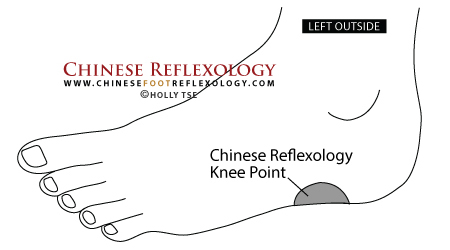
How to Locate and Massage the Chinese Reflexology Knee Point
- Location: There’s a Chinese Reflexology knee point on each foot. It’s a semicircle—slightly wider than the width of your thumb—located on the outside edge of the foot where the skin meets the sole. To locate this point, feel along the edge of your foot in the area in front of your ankle. You should feel a slight indent right in front of the heel.
- How to massage: To massage the knee reflexology point, apply moisturizer or massage oil to reduce friction since this point is on the side of the foot where the skin is more sensitive than the sole of the foot. Then reach down and use the index finger knuckle of the same side hand (e.g. left hand for left foot) to massage the point back and forth, so you’ll rub towards your toes and then away from your toes.
- How often to massage: If you have a knee injury, massage the knee reflexology point three times a day for 60 seconds. You’ll definitely want to use moisturizer or massage oil to reduce friction when you’re massaging this often. If one knee is sore, massage the point on the foot of the leg with the sore knee. If both knees are sore, massage the reflexology point on both feet. During the acute phase of the injury, continue massaging three times a day. Then gradually reduce the amount of massage until your knees are better. E.g. 60 seconds twice a day reducing down to 30 seconds a day.
4. Poop Assistance Points
When nature is calling and you’re in an unfamiliar restroom, it’s common to experience temporary constipation, especially if you have to do your business outside, or in campground facilities where you don’t feel very relaxed (i.e. dirty toilets or lots of mosquitoes flying around).
 When you’re feeling uncomfortable, this can create tension in your abdomen, and then it’s harder to have a bowel movement. Fortunately, there’s a combination of Chinese Reflexology points to get things moving. [Note from Holly: So many students and friends have told me that these points work like a charm.]
When you’re feeling uncomfortable, this can create tension in your abdomen, and then it’s harder to have a bowel movement. Fortunately, there’s a combination of Chinese Reflexology points to get things moving. [Note from Holly: So many students and friends have told me that these points work like a charm.]
Oh, by the way, the Chinese Reflexology points I’m going to share with you are on your hand so you don’t have to be rubbing your feet while on the throne. Talk about awkward!
How to Locate and Massage Chinese Reflexology Points on the HAND for Temporary Constipation
- Location: This is a combination of points located solely (get it? bad pun intended) on your LEFT hand. These points are different on the left hand than on the right hand, so don’t massage these points on your right hand. There are four points: the transverse colon, the descending colon, the sigmoid colon, and the anus.
- Transverse colon: horizontal line located about halfway down the palm
- Descending colon: vertical line located along the edge of the palm below the baby finger. It begins at the end of the transverse colon point and goes down until about a thumb-width above your wrist crease.
- Sigmoid colon: horizontal line that begins at the end of the descending colon and continues to the thenar eminence of your thumb. That’s the big fleshy pad of your thumb that makes up part of your palm.
- Anus: small circle at the end of the sigmoid colon point, just below the center of your thenar eminance. If you imagine a point right in the center of the big fleshy pad of your thumb (see the “x” on the diagram), the anus reflexology point would be located just below it.
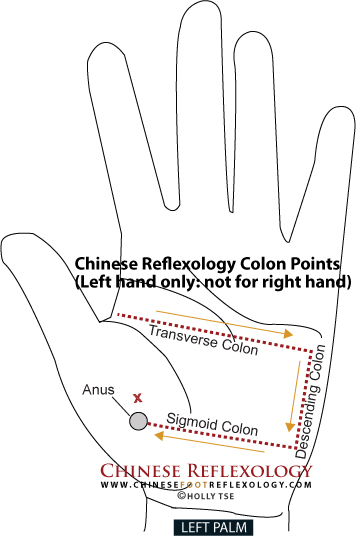
- How to massage: Place the knuckles of your right hand at the beginning of the transverse colon near your thumb. Stroke from LEFT to RIGHT, then continue massaging down the descending colon point (away from finger tips towards wrist) using the middle finger knuckle. When you get to the bottom of the descending colon, use all of the knuckles again to stroke the sigmoid colon point, massaging from RIGHT to LEFT. It’s important to massage in the specified direction. When looking at your left palm, you massage these three points together as one continuous stroking in a clockwise direction. For the anus point, use your index knuckle to press and twist on the point.
- How often to massage: When you’re sitting on the toilet with temporary constipation, massage the transverse, descending, and sigmoid colon points as one continuous stroke, making sure you follow the correct direction (clockwise when looking at your left palm). When you get to the end of the sigmoid colon point, lift up your knuckles of your right hand, place them back at the start of the transverse colon, and repeat. Do 15 clockwise strokes. Then massage the anus point for 10 to 15 seconds. Rest, relax, breathe (as best as you can in a stinky stall), and repeat once more. Then try pooing.
5. Bug Points
Having recently visited northern Ontario and getting swarmed by deer flies the moment I stepped out of the car, I totally wished there was a reflexology point that worked as a natural bug repellent. Unfortunately, there isn’t one. After being bitten numerous times by mosquitoes, I also wished there was a point that would make the itching and swelling disappear instantly. Even getting relief from the itching would’ve been great. However there isn’t one of those points either.
 What you can do though is massage the Chinese Reflexology point for lymphatic drainage to help flush the toxins from the mosquito bite out of your body faster. When a mosquito bites, it injects saliva into the bite. The itching and swelling is your body’s reaction to the saliva.
What you can do though is massage the Chinese Reflexology point for lymphatic drainage to help flush the toxins from the mosquito bite out of your body faster. When a mosquito bites, it injects saliva into the bite. The itching and swelling is your body’s reaction to the saliva.
Increasing the flow of lymph, qi and blood helps clear the saliva and subsequent reaction out of your system faster. You’ll still get your usual reaction to bug bites, but the increase in circulation will help flush things out faster so that the itching and swelling goes away a little quicker.
WARNING: Do not massage the lymphatic drainage if you are pregnant because this reflexology point crosses over Liver 3, which is used to induce labor.
How to Locate and Massage the Chinese Reflexology Lymphatic Drainage Point
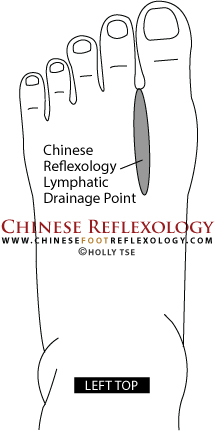 Location: This reflexology point is located on both of your feet in the webbing between the bones of your big toe and second toe.
Location: This reflexology point is located on both of your feet in the webbing between the bones of your big toe and second toe.- How to massage: To massage the reflexology point for lymphatic drainage, you may want to apply moisturizer or massage oil to reduce friction since this point is on the top of the foot where the skin is more sensitive than the sole of the foot. Use your index finger knuckle to press and stroke from the base of your toes towards the point of the V that’s formed where the bones of the big toe and second toe meet. ONLY stroke in this direction away from the toes and towards the V. When you get to the bottom of the point at the V, lift up your knuckle and place it back at the base of your toes to stroke downwards again. I should also mention if you have a bug bite on this spot, don’t massage the point or you’ll simply irritate the area.
- How often to massage: Massage 15 downward strokes twice a day on each foot until your bug bites get better.
There are two additional acupressure points to help improve the flow of qi and blood in your body. You can find a detailed description on how to locate and massage these acupressure points in my article on 4 Points on Your Feet for Headaches and Migraines. Simply look for “Four Gates” in the article and follow the instructions. As long as you’re not pregnant, you can press and hold these points for 60 seconds twice a day after massaging your lymphatic drainage point.
